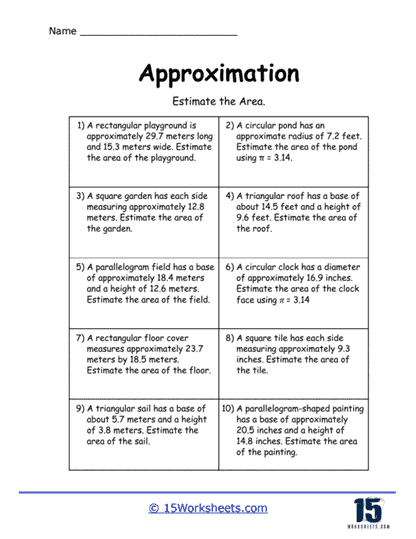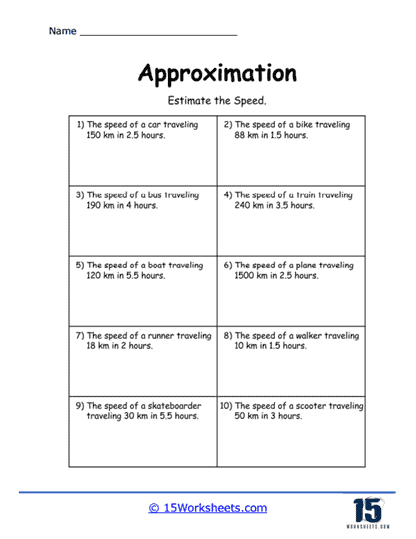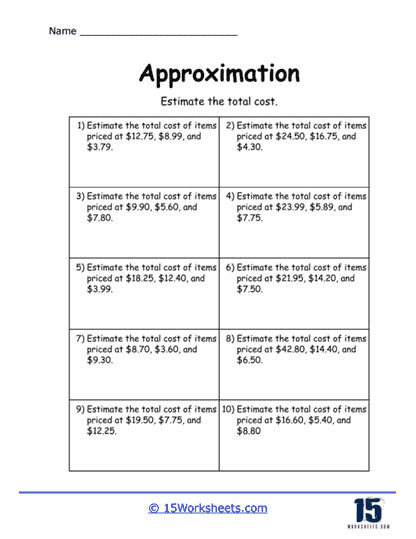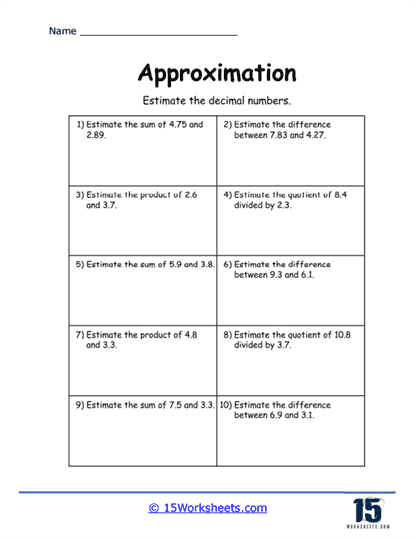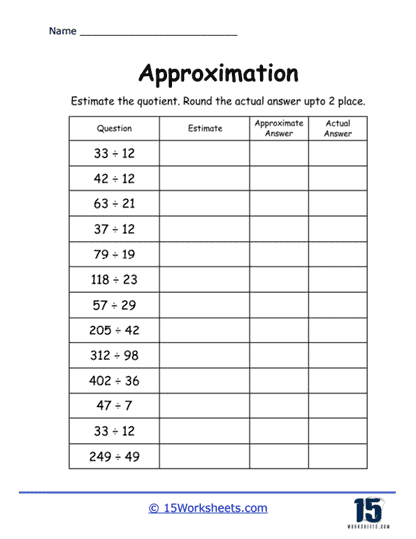Approximation Worksheets
About These 15 Worksheets
These worksheets are an invaluable for students learning how to estimate and round numbers, helping them simplify complex calculations and make quick, reasonable guesses. In math, exact numbers aren’t always necessary, and learning to approximate is an essential skill that translates to real-world problem-solving, such as budgeting, measuring, or making quick calculations on the fly. Approximation allows students to get close to the correct answer without needing to perform lengthy or complex computations, fostering a more intuitive understanding of numbers. These worksheets offer a wide range of activities that challenge students to round numbers, estimate sums, and work with various forms of approximations.
One of the key features you would expect to find on an approximation worksheet is rounding. Rounding exercises are crucial for teaching students how to simplify numbers by adjusting them to the nearest ten, hundred, thousand, or any other place value. For example, rounding 47 to the nearest ten would give you 50. Worksheets typically include problems that ask students to round individual numbers, like rounding 842 to the nearest hundred, or rounding numbers in a word problem context, like estimating the cost of multiple items in a shopping cart. Rounding exercises help students develop a strong sense of place value, understand the importance of digits, and improve their mental math abilities.
Our approximation worksheets also include activities that involve estimating sums, differences, products, and quotients. These types of problems are essential because they teach students to quickly assess the outcome of a mathematical operation without needing to solve it exactly. Estimating sums or differences might involve rounding the numbers involved and then adding or subtracting, such as estimating 47 + 38 by rounding both numbers to the nearest ten, giving an approximate sum of 50 + 40 = 90. Similarly, estimating products and quotients may involve rounding the factors or the divisor and dividend to simplify the calculation. Estimation skills allow students to make quick, logical judgments and are particularly useful in everyday tasks, such as figuring out approximate totals when shopping or budgeting.
In more advanced approximation worksheets, students may encounter problems that require estimating the outcomes of more complicated calculations, like those involving fractions or decimals. For example, students might be asked to estimate the sum of two fractions by rounding each fraction to the nearest whole number or half. Estimating with decimals might involve rounding to the nearest tenth or hundredth to simplify a calculation, such as estimating the product of 4.67 and 3.2 by rounding the numbers to 5 and 3, respectively. These types of exercises help students develop a deeper understanding of how fractions and decimals function within the number system and how they relate to whole numbers.
Another important component of approximation worksheets is teaching students to estimate square roots and powers. Problems involving square roots might ask students to estimate the square root of a number that is not a perfect square, such as estimating the square root of 50 by recognizing that it is between the square roots of 49 and 64. Estimating powers might involve determining whether a given number raised to a power is closer to one benchmark value or another. These types of problems encourage students to think critically about the relationships between numbers and improve their number sense, particularly when working with irrational numbers or complex expressions.
We also include word problems that require students to use estimation as a problem-solving strategy. For example, a word problem might describe a scenario where a person is purchasing several items at a store, and the student is asked to estimate the total cost by rounding the prices. Or, a problem might describe a situation in which someone is measuring ingredients for a recipe, and the student must estimate the amount of a particular ingredient based on the given measurements. Word problems like these provide context for approximation, allowing students to see how estimation is used in everyday life and how it can simplify more complicated problems. These exercises also help students develop critical thinking skills by requiring them to choose the most appropriate form of estimation for the situation.
Another interesting aspect of approximation worksheets is working with error bounds or ranges of values. This type of activity asks students to estimate a number and then determine a reasonable range within which the actual answer might fall. For example, a worksheet might ask students to estimate the total cost of three items in a store and then determine an upper and lower bound for their estimate, considering factors like tax or discounts. Understanding error bounds teaches students that estimation is not about finding the exact answer but about getting close enough for the situation at hand. This concept also helps students build confidence in their ability to work with approximate values in fields like engineering, science, and finance.
Teachers might also incorporate visual aids in approximation worksheets, such as number lines, charts, or graphs. These visual tools help students better grasp the concept of estimation by allowing them to see the range of possible values. For example, a number line might be used to show where a number falls in relation to its rounded value, or a bar graph might be used to estimate quantities based on visual comparison. Visual aids can be particularly helpful for younger students or visual learners who benefit from seeing the relationships between numbers in a more concrete way.
Whether it’s rounding numbers, estimating sums and differences, working with fractions and decimals, or solving real-world word problems, these worksheets offer students the opportunity to practice and refine their estimation abilities. They teach essential skills like place value, mental math, and critical thinking, while also preparing students for more advanced mathematical concepts like significant figures and scientific notation. Approximation worksheets play a key role in building students’ confidence in their ability to make reasonable guesses and judgments in math, which is a crucial skill both in the classroom and in everyday life.

